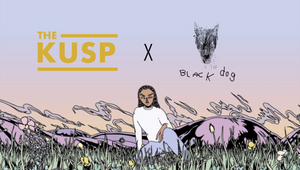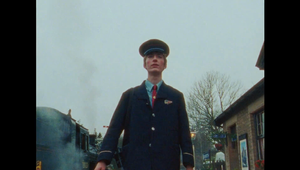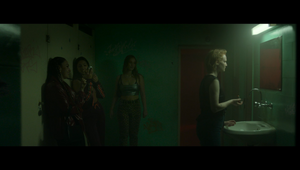
Tipped for Greatness: Meet the Creative Circle’s Most Promising Creatives

LBB’s Uprising channel is brought to you in partnership with Ridley Scott Creative Group, in ongoing efforts to facilitate opportunities for the next generation of creative talent.
The Uprising channel amplifies the voices of emerging talent in the industry, and with the support of Ridley Scott Creative Group, the industry’s top talent will have an even louder voice on LBB’s global platform. The channel is an opportunity for up-and-coming talent to be celebrated for their artistry, personality, and inspirations, with each feature exploring their creative background, niche craft obsessions, the work they are most proud of, and views on the state of the industry.
Talent categories at the Creative Circle awards are free to enter in support of the next generation of up-and-coming young creatives, with every UK-based creative in their first three years of working free to submit their work. The Creative Circle is the only award show which invites the entire UK Creative community to judge the submitted work, with registration open to any creative currently working in the creative industries in the UK.
After being judged by hundreds of creatives in that jury process, the 2023 winners were announced in July. We spoke to the winners and finalists in the Most Promising Creative Individual and Most Promising Creative Team categories to get to know these creative stars of tomorrow.
Hannah Neil
Creative Director
UNIT9
Winner – Most Promising Creative Individual

How and when did you realise you wanted to be a creative?
Hannah> Growing up I always found myself playing with my mum's old version of 2002 Photoshop which inspired a career path in design. However, while studying graphic design at university I found I gravitated most to the ideation stage of projects. Nothing quite beats the buzz of finally cracking an idea. It was only when I joined UNIT9 that I shifted from design to creative direction, where I have been able to collaborate with our extremely talented teams to bring to life our ideas.
How did you get your start in the industry?
Hannah> I graduated in the middle of the first wave of lockdowns when job boards were a barren wasteland. Knowing the traditional methods were no hope, I decided to start reaching out to creatives for advice. I connected with Steve Price, the founder of #ShoutOutToHelpOut which is an ongoing campaign to help share new graduates’ work with the creative industry. After reaching out, he very kindly shared my portfolio with his network. The next day I received an email with an invitation for an interview at UNIT9 and I have been here ever since! I think it’s a really beautiful side of our industry that there are so many creatives willing to help and share their wisdom with others.
What are some of the most significant projects you’ve worked on?
Hannah> The first project I led at UNIT9 was an immersive web experience for Netflix, celebrating the final season of ‘La Casa de Papel’ (‘Money Heist’). We created an interactive global map where fans could share their messages of resistance inspired by the show. It was amazing to work on a project with such a passionate fan base and watch as thousands of messages were being left on the site from all over the world.
Vodafone's ‘Wimbledon Walk of Champions’ is another favourite project of mine. In a VR experience, we gave tennis fans the chance to complete the ‘Walk of Champions’, a walk down the halls of the iconic Wimbledon Clubhouse to Centre Court exclusively reserved for players. With narration from tennis legend Tim Henman and the Masters of Ceremonies, fans were able to discover and explore iconic moments from The Championships history before stepping out onto Centre Court to the cheering crowds. The project was an amazing opportunity to be able to dive deep into the legendary history of The Championships.
What does it mean to be a junior creative in London?
Hannah> It is brilliant to have so much creativity on your doorstep. There are of course the many galleries and exhibitions on offer, but there is also so much creativity in the everyday - from the beautifully designed menu in the local café, to strolling through a pop-up craft market.
Josephine Rasmussen & Marie Jensen
Creatives
Saatchi & Saatchi UK
Winners – Most Promising Creative Team

How and when did you realise you wanted to be creatives?
Josephine & Marie> A bit by accident, really. We both had no idea that the school we got into was an advertising school. Maybe that says more about us, but it’s called Creative Communication (The Danish School of Media and Journalism) – and that’s a pretty vague name, right? Luckily, we both really enjoyed it!
How did you get your start in the industry?
Josephine & Marie> Our start in the UK advertising world was when we won Cream, straight out of ad school. It really felt like momentum, so when we heard that the Cream event was going to be online because of covid, we decided – let’s just give it a shot, go to London and see what happens! We literally typed “creative director UK” and added everyone, shared that we were going to London and luckily other people shared it, which we are eternally grateful for. We went to London for a week (lockdowns were lifted by this point), met a lot of agencies and then, on our last day we got offered our first job at CPB London!
What are some of the most significant projects you’ve worked on?
Josephine & Marie> Our first ever campaign we did, when we had just moved to London, was for Tinder – and it will always be a significant project to us. It was literally a dream come true and a real pinch-me moment.
But our Imagine campaign for International Women’s Day 2022 probably holds the biggest significance for us. We are so proud of it, and it opened a lot of doors with some really cool brands who wanted to do female-first campaigns. We created a condom garden for HANX biodegradable condoms and a campaign for ASICS around women’s mental health. This is some of the work we are really proud of.
What does it mean to be a junior creative in London?
Josephine & Marie> London is an inspiring city to do advertising in. People are passionate and energetic and excited about it. We’ve been lucky enough to work on both big and small briefs – often you learn fastest when you’re thrown into the deep end a bit. It’s also nice getting to work with a lot of different creative directors; you realise that there’s not one right way, but a million different ways to be in advertising.
Also, just letting everyone know, junior creatives are just always really nice to each other! No sharp elbows, only good vibes. Maybe because we are all secretly planning and plotting how we’re going to take over this industry one day…!
Emily Cuthbert
Creative
McCann Bristol
Finalist – Most Promising Creative Individual

How and when did you realise you wanted to be a creative?
Emily> I was on a walk with my parents one day. I must have been about seven years old and my Dad pulled a tiny Twirl chocolate out of his pocket to give me. A keen ballerina at the time, I remember having a rush of an idea for a TV ad. What if everyone in the street started twirling like a ballerina when they ate a Twirl? It took another decade for me to realise you could dream up these bizarre, enlightening and poignant creative thoughts as a job.
(Oh and Cadbury, you know where I am.)
How did you get your start in the industry?
Emily> It’s a wonderful chain reaction that I’m still riding today. I studied English literature at The University of Sheffield. One evening, I popped into a careers networking event and met a local events company owner. He introduced me to Sheffield-based agency Jaywing and after interning there between lectures, I landed a graduate job at the newly formed McCann Leeds as the very first member of their creative team.
Last year I traded Yorkshire for the South West, and moved within the McCann network to the brilliant Bristol office, which brings us right up to now. Mix all that together in a pot of freelance illustration and a marketing placement year at Unilever, and you have my starting story.
What are some of the most significant projects you’ve worked on?
Emily> The projects that make my heart sing have all been rooted in place and community, which is what the regional agency experience gifts you. University of Leicester’s undergraduate student campaign, Edinburgh International Festival’s 75th anniversary brand campaign and a handful of campaigns for LEEDS 2023 Year of Culture feel the most significant to me. Each of them felt important to their respective cities, from giving the mic to Leicester’s truly diverse student population, to reflecting Edinburgh as a global epicentre to all cultures, to showcasing Leeds’ unique attitude on the global and local stage.
What does it mean to be a junior creative in Bristol?
Emily> Bristol is a city of colour, experimentation, and rebellion. The place you work plays a huge part in your creativity, so you can’t help but notice the city permeates into your thinking the more time that you spend here. Bristol has a phenomenal do it yourself attitude to creativity too, which is endlessly inspiring. It’s like a huge, never-ending collage that you just want to get stuck in with and contribute too.
David Popa
Artist
MTArt
Finalist – Most Promising Creative Individual

How and when did you realise you wanted to be creative?
David> My father is a professional artist, so as a child I was encouraged to draw, paint and make movies. However as a kid I loved movement and sports, so it wasn’t until I found large scale murals/street art that I felt these two worlds collide and wanted to pursue it professionally.
How did you get your start in the industry?
David> I just took advantage of every opportunity I could to paint. I began on legal graffiti walls and got opportunities to create large scale murals on buildings etc. I found myself unable to really grow and move forward in my career until I decided to experiment with natural materials and create large land art pieces directly in nature. Ultimately this shift opened my entire creative career.
What are some of the most significant projects you’ve worked on?
David> I recently collaborated with Apple TV+ for the release of Prehistoric Planet season 2 where I created massive earth frescoes of dinosaurs. However the most significant project for the launch of my career has been creating works of art on ice floes in the Baltic Sea near where I currently live in Finland.
Gémina Flores & Jemma Burgess (AKA G/Jems)
Creatives
McCann London
Finalists – Most Promising Creative Team

How and when did you realise you wanted to be creatives?
Gémina> It's going to sound a bit cliché, but I don’t think I ever ‘realised’ I wanted to be a creative, I was always a creative. I started taking painting classes around age three and my first ever piece from then – a re-interpretation of 'La Danse' by Matisse – is still proudly hanging in my brother's apartment. Then around age 14 I heard the job title ‘art director’ and it instantly sounded like the coolest job ever and became what I wanted to do, even if I didn’t really know what it meant. Thankfully now that I do it, I still think it’s the coolest job ever.
Jemma> There wasn’t ever really a specific moment where I realised that I wanted to be a creative. I was just always thoroughly uninterested in anything that was boring. I really struggled with the notion that as you got older you were told things got more serious and you had to stop playing. In fact, I totally rebelled against it. And whilst all my friends went to uni, I went to drama school. Spent three years dressing up as imaginary characters before deciding it might be fun to write my own. After writing my first play for the London stage it seemed clear that being a professional day dreamer was what I really wanted to do.
How did you get your start in the industry?
Gémina> Went to ad school, met my creative partner, built a portfolio together, emailed it to all the agencies in London, emailed it again, and again… Landed a placement that turned into a job and here we are three years later. Sounds easy but it was a journey full of stress and doubt, but I learned resilience in the process and I’m very grateful for that. Resilience and hard work can take you anywhere you want in your life.
Jemma> I somehow wangled my way into the School of Communications by performing a spoken word piece about dyslexia before bursting into an interpretive dance to the sound of Cher’s ‘Believe’. It involved a lot of glitter. Then after nearly a year of graft and a lot of tears I was forced to work with my now creative partner Gem. A choice purely down to the fact we share the same name. Luckily, we also shared the same work ethic and passion for making non-traditional campaigns. With this we ended up winning Cream, sneaking our book under [TBWA\London CCO] Andy Jex’s nose who thankfully offered us a placement.
What are some of the most significant projects you’ve worked on?
Gémina> Your most significant project should always be the one you are currently making, right? We’ve just shot a commercial for one of our clients, hopefully the kind of piece that can impact culture positively. But I would consider #FollowedByCancer that we did with Twitter to be the most important one, as it raised awareness for an important cause. And our adidas campaign with Jenna Ortega of course. We got so lucky to work with her just as Wednesday was being released.
Jemma> What Gem said.
What does it mean to be a creative in London?
Gémina> I think London is the best city in the world to be doing this job. I can go about this for hours as I truly think there is no place like here. Yes, it's bad weather and relatively bad food and my Spanish dad will never get it – but what London does best is: people. Those who live here are often very open, it’s a multicultural city, so people are used to and comfortable with others being different, meaning you can truly be who you want to be. Which is the environment to be a happy creative.
Jemma> It means that one day you might be coming up with posters to raise awareness for Alzheimer’s and the next writing silly scripts for super noodles. It means you better have tough skin and be prepared to throw your ego in the bin. It means imagining stories and solving problems. Every day. It's late nights and early shoots. Working hard but hardly working. It’s a lot. But it’s a lot of fun.
Leah Winson & Rhianna Travers
Creatives
St Luke's
Finalists – Most Promising Creative Team

How and when did you realise you wanted to be creatives?
Leah & Rhianna> We both studied art at school, but when it came to choosing a university course, we were drawn to Advertising as it felt like a more practical use of our creativity. We met while studying creative advertising at the University of Lincoln, and it was there that we both fell in love with the creative process. Advertising is a wonderful melting pot of so many other subjects – it's about psychology, design, and writing. The feeling you get when you come up with an idea that excites you is like no other, a sort of adrenaline rush. It's that feeling that made us certain we wanted to be creatives.
How did you get your start in the industry?
Leah & Rhianna> In 2020, we graduated from university during the peak of covid, making breaking into the industry even more challenging than usual. We used this to our advantage and spent much of the following year polishing our book and reaching out to creatives in the industry for book crits. Our big break came when Rich Denney, our CCO at St. Luke’s, offered us a placement. Our first month in the industry was incredibly exciting. We had the opportunity to work on the South Western Railway pitch, which is now one of St Luke’s biggest accounts. At the end of the month, we were asked to stay permanently, and we have been here ever since.
What are some of the most significant projects you’ve worked on?
Leah & Rhianna> In our first year in industry, we were briefed to write two TV ads for Tyrrells crisps. Not only did we write the scripts but we also sourced every piece of Pathé footage used in the ads. It was an incredibly rewarding project to work on and, as it’s our first born, it will always have a special place in our hearts. One of our more recent projects is our Heathrow ‘Destinations’ campaign, a campaign that will run throughout 2023. The idea behind the campaign came from the observation that flight paths have a visual symmetry to ski tracks. We have taken that idea and found ways of integrating it into landscapes all over the world. We love this campaign because of its simplicity, which is something we always try to prioritise in the work we create.
What does it mean to be a junior creative in London?
Leah & Rhianna> Being a junior creative is about owning the fact that you don’t know everything while still being confident enough to offer your opinions and insights. It’s about being a team player and supporting other creative teams when needed. It’s about rolling with the punches and seeing ideas you love get killed, then coming up with even better ones. It’s about having your finger on the pulse and bringing a fresh perspective to every project. Most importantly, it's about having fun with it and not taking things too seriously – after all, it's only advertising.
Beck Dunn & Freddie Mickshik (AKA Freck)
CreativesDentsu Creative
Finalists – Most Promising Creative Team

How and when did you realise you wanted to be a creative?
Freck> For Freddie, it was in the middle of a lucid dream where he was surrounded by giant talking sofas and ticking deadline clocks (he worked as a removal man and account exec beforehand). That fateful night he suddenly shot out of bed, turned to his knee high desk and wrote down a few lines that dictated his future forever. It was a headline about the new Big Mac with Bacon for just $2.99. In that moment Freddie realised two things, that he wanted to be a copywriter and that he was hungry.
For Beck, it was at the 49th hour of a 50-hour painting exam where he realised he didn’t even really like painting.
Like many people we both knew we were creative but didn’t know where to direct it, so after some time reconsidering our interests and a lot of luck we discovered the School of Communication Arts 2.0, where the interview process required you to talk about yourself for 15 minutes straight. Beck used his Art skills to perform a speech about tequila with a live mariachi band, while Freddie used his writing skills to create tinder cut outs for each mentor from the course on it. The SCA was where we realised for certain that we wanted to be advertising creatives.
How did you get your start in the industry?
Freck> We got our first placement and start in the industry at Gravity Road by a hilarious lack of judgement on our part. During a blur of back to back portfolio day book crits, we thought we had a 10-minute break before the next one, so naturally we started singing and choreographing a dance to ‘Mambo No. 5’ in Beck’s living room while wearing matching Hawaiian shirts.
It wasn’t until three minutes into the routine we realised the wonderful Sophie Cullinane was watching us perform on zoom, it was only when she came off mute and told us that we realised our mistake. Yet still, after reviewing our work and having a great laugh she gave us our first step into the industry and taught us the social & digital ropes. Shout out to Sophie!
What are some of the most significant projects you’ve worked on?
Freck> At Dentsu Creative we’ve had the chance to work on some great projects. Some of the most memorable ones include the first DC Christmas card, which won Campaign’s agency Christmas card this year and a gold at Designweek. A couple weeks ago we also got to create our very own F1 pit team for Hilton Hotels at the Silverstone Grand Prix known as the Hos-Pit-ality Crew. Rather than changing tires, they provided race fans with toiletries, dressing gowns and breakfast boxes, not to mention… unlimited DoubleTree cookies, all at breakneck speed to real fans. As well as those, we got to learn about OOH craft with posters for TellMi, an anonymous social media app for young people, which went live across London using real quotes from young people talking about mental health on the app.
What does it mean to be a junior creative in London?
Freck> We’re both from London and we feel very lucky to be working in our home city, the truth is that it can be really hard and not just from navigating the tube. Firstly, there’s a lot of competition in London to get hired at the agencies you love, then once you’re in, you learn quickly that you have to compete even harder to win briefs and stand out internally in order to convert your placement into a job.
Being a creative in London also pushes you. You’re surrounded by some of the best agencies in the world and when they release work it makes you want to work even harder to make something better, which in turn makes you grow.
We’ve found that it helps to keep being driven and hungry for the opportunities to make work, even after getting hired. To learn from those around you who will make you better, and to not put too much pressure on yourself. Even though you feel like you have to crack every brief you’re given, you don’t. So far we’ve managed to survive.















